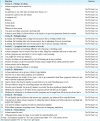Quality of asthma management in an urban community in Delhi, India
- PMID: 22446860
- PMCID: PMC3336849
Quality of asthma management in an urban community in Delhi, India
Abstract
Background & objectives: High prevalence and poor control of asthma make its management a major public health issue worldwide, especially in developing countries. Optimum review of asthma management in the community is essential to improve asthma control. This study was conducted to investigate the quality of asthma management, knowledge about asthma and quality of life of asthma patients referred to a public tertiary care chest hospital in Delhi.
Methods: Diagnosis of asthma was confirmed by symptoms and reversible spirometry in 50 referred patients on their first visit. Patients were interviewed using three questionnaires on quality of asthma management before visiting referral hospital, asthma knowledge and asthma quality of life (AQLQ). Correlation amongst quality of treatment, asthma quality of life, and asthma knowledge was also determined.
Results: Findings revealed that only 60 per cent of patients were informed about their disease, and 10 per cent had undergone lung function tests previously. Only 44 per cent of patients were prescribed inhalers. None were provided with any educational material. Patients had poor knowledge of aetiology, pathophysiology, medication and how to assess the severity of their asthma. The mean scores in AQLQ indicated a moderate degree of impairment in quality of life. INTERPRETATIONS & CONCLUSIONS: This study provides evidence of unsatisfactory asthma management and patient-doctor interaction as patients had limited knowledge of asthma disease, its management and had poor quality of life as measured by a standardized questionnaire. Thus, there is need to implement suitable interventions to improve asthma management according to standard treatment guidelines in the community.
Figures
Comment in
-
Do we care asthma?Indian J Med Res. 2012;135(2):157-9. Indian J Med Res. 2012. PMID: 22446856 Free PMC article. No abstract available.
References
-
- Masoli M, Fabian D, Holt S, Beasley R. The global burden of asthma: executive summary of the GINA Dissemination Committee Report. Allergy. 2004;59:469–78. - PubMed
-
- Aït-Khaled N, Enarson DA, Bencharif N, Boulahdib F, Camara LM, Dagli E, et al. Treatment outcome of asthma after one year follow-up in health centres of several developing countries. Int J Tuberc Lung Dis. 2006;10:911–6. - PubMed
-
- Kwong KYC, Morphew T, Scott L, Guterman J, Jones CA. Asthma control and future asthma-related morbidity in inner-city asthmatic children. Ann Allergy Asthma Immunol. 2008;101:144–52. - PubMed
-
- García-Marcos L, Castro-Rodríguez JA, Montaner AE, Garde JG, Bernabé J, Belinchón JP. Spanish Pediatric Asthma Study Group. The use of spirometers and peak flow meters in the diagnosis and management of asthma among Spanish pediatricians. Results from the TRAP study. Pediatr Allergy Immunol. 2004;15:365–71. - PubMed
-
- Van Sickle D. Low-cost, open-source spirometry. 2009. [accessed on November 8, 2010]. Available from: http://davidvansickle.com/2009/02/low-costopen-source-spirometry/,



